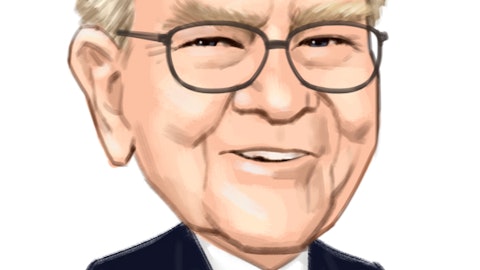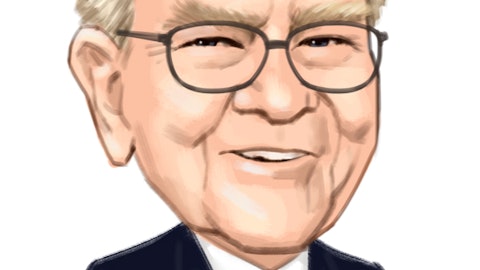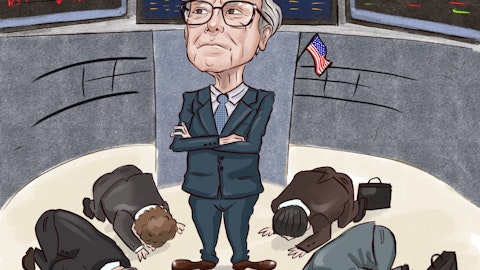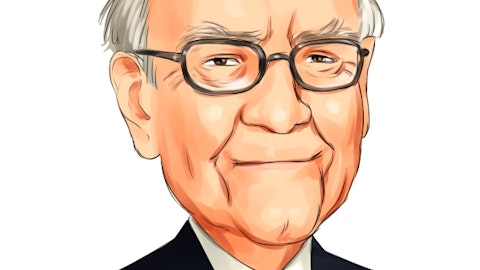Kevin McVeigh: Thanks so much and really nice results. If we went back, you were able to reaffirm the medium-term targets. Obviously, you reset the base here but a pretty dramatic shift in ’22 relative to initial expectations. I don’t know if this would be for who, but just any thoughts on puts and takes? Is it that analytics has been overperforming a little bit relative to the downturn in MIS? Just any puts and takes as you think about kind of what the initial targets were.
Mark Kaye : Kevin, it’s Mark. So maybe I’ll talk just thematically, I’ll start with our base case assumptions because our medium-term guidance, as you know, refers to a time period within five years, with 2022 as the base year. And that incorporates various assumptions as of the end of January. And those include, for example, U.S. and euro area GDP to stagnate in the near term, followed by recovery, U.S. 10-year treasury yield to stabilize, fluctuating modestly around current levels, issuers continuing to refinance maturing debt. And then on the MA side, customer retention rates to remain in line with historic levels, and of course, pricing initiatives to align with prior practices and our enhancements to customer value. If I maybe pick, to your question, two specific examples, maybe two tailwinds to headwinds.
On the tailwinds side, issuance activity tends to track GDP growth over the medium to long term. And our central case models GDP expansion at a level consistent with what prevailed prior to the COVID-19 pandemic. And we’ve used our GDP and interest rate predictions from Moody’s Analytics forecast, which shows that the 2014 to 2019 average annual real GDP growth was between 2% and 3%, and that’s sort of what we expect going forward. The second tailwind is something we spoke about extensively on prior calls, that’s based on our maturity wall studies. U.S. corporates have $1.9 trillion in maturing debt. The majority, we expect to be refinanced. Similarly, European corporates have refunding needs around $2.1 trillion. And then on the headwinds side, the first one maybe is worth noting is we do project interest rate increases — sorry, we do project interest rates are going to remain elevated and that may potentially impact opportunistic financing.
For example, in the U.S., we model a near-term increase in the 10-year treasury yield. And then we expect that to remain roughly stable at that 4% through 2027. And then finally, in resetting our medium-term target base to 2022, we have assumed constant currency foreign exchange rates over the five-year period, specifically the euro at 1.07 and the pound at 1.20. And that shows dollar appreciation versus the original rates we gave in February last year, which were 1.14 and 1.35.
Operator: Your next question comes from the line of Alex Kramm from UBS.
Alex Kramm : Can you just shift gears to capital allocation for a second? Maybe I missed it, but the $250 million in share repurchases seems fairly low relative to what you’ve been doing in the past and obviously also the free cash flow guidance. So is there a shift of thinking on what are the uses of cash? And then obviously, does that also suggest that maybe on the M&A side, you’ve taken a harder look, again, maybe in a different environment from a buyer and seller perspective?
Mark Kaye : Alex, best place for me to start is to reaffirm that our capital planning and allocation strategy is unchanged. We remain committed to anchoring our financial leverage around a BBB+ rating, which provides, in our view, the appropriate balance between ensuring ongoing financial flexibility and lowering the cost of capital. Given, however, that our gross leverage as of year-end was above 2.5x, and that, as we know, is driven by the cyclical market conditions we just experienced. And as we head into 2023, we want to retain the financial flexibility to marginally deliver our balance sheet and improve our gross outstanding debt position if needed. And that’s similar to the actions that we took in the fourth quarter through our tender offer.
And what that means for 2023 is our plan is to return approximately $800 million of our global free cash flow, it’s about 53% at the midpoint, to our stockholders, subject, of course, to available cash, market conditions, M&A opportunities, et cetera. And that includes, to your question, the share repurchase guidance of $250 million and approximately $560 million in dividends through a quarterly dividend of $0.77 per share, which is 10% up from our prior quarterly dividend. And it’s all about creating that flexibility to evaluate opportunities as the year goes on.
Operator: Your next question comes from the line of Toni Kaplan from Morgan Stanley.
Toni Kaplan : Wanted to ask about the free cash flow guide. Part of the reason why it was maybe a little bit lower than what I thought was the CapEx sort of staying at the $300 million range, roughly, let’s call it like 5% of revenue. Should we expect that level to continue? Are you at sort of a different CapEx just percentage-wise because of the change in model? Or I guess, what’s driving it? Is 5% the right number to be thinking about for future years as well?
Mark Kaye : Toni, thank you for your question. Let me maybe start by saying the midpoint of our cash flow guidance range implies growth of approximately 25% off of our reported 2022 free cash flow result. And that’s well above the projected midpoint, which is low double-digits for our U.S. GAAP net income. And in addition, what that really means is at the midpoint, the free cash flow to U.S. GAAP net income conversion ratio is approximately 100%. And that’s effectively equal to the average free cash flow conversion ratio that we’ve had over the last four years, meaning specifically from 2019 to 2022. So we feel pretty comfortable with that as a result. In terms of CapEx, 2022 actual result was $283 million. We’re guiding to approximately $300 million, i.e., a similar level.
And there are a number of factors underpinning that guidance, specifically, for example, continued M&A integration activity, for example, related to PassFort or kompany or RMS. There’s ongoing enhancements to IT platform and our real estate infrastructure associated with the workplace of the future program. But one of the big drivers that will carry forward into 2023 is effectively the higher amount of capitalizable work under GAAP related to our SaaS-based solutions for our customers. And that ties in directly with the underlying business strategic shift to provide more SaaS-based, more recurring revenue solutions within MA. And so I think it’s a step-up in 2023. I don’t think we’ll see a separate step-up in future years, but that’s really what’s driving the underlying numbers.
Toni Kaplan : Terrific. And just as a really quick follow-up. I know last quarter, you were sort of saying that you thought third quarter and fourth quarter would be the trough for the issuance declines, and that it should improve throughout 2023, in particular, second half. I feel like there’s some consistency in the messaging that second half is going to be better than the first half. But like, I guess, have you delayed your expectation for issuance recovery? Or is it still similar to where you were thinking it was going to be last quarter?
Rob Fauber : Not really. Toni, it’s Rob. Not really a change. It’s pretty consistent with how we thought about it last quarter. I think one thing you’re hearing from us is just the first quarter of 2022 has a relatively robust issuance here. So there is the matter of comps, but I don’t think there’s any fundamental change from how we were thinking about the kind of troughing and recovery in issuance.
Operator: Your next question comes from the line of Ashish Sabadra from RBC Capital Markets.
Ashish Sabadra : I wanted to focus on the Moody’s Analytics business. We saw some pretty good robust strength there and the guidance also implies further acceleration. Mark, in your — in response to a prior question, you talked about the seasonality but also talked about like a similar growth profile across all three units within MA. But it seems like based on that bubble chart on Slide 9 that you may have some faster growth businesses within Decision Solutions. So I just wanted to better understand how should we think about some of the growth businesses within all the three segments within MA?
Rob Fauber : Yes. Ashish, it’s Rob. Let me — maybe let me start since the question is really about MA growth. Maybe let me just start with kind of the ARR, and then I can zero in a little bit on kind of what’s contributing to that. But we talked about on the last call that we’ve got RMS now in the MA ARR figure. And I think we’ve also talked about the fact that RMS is not quite yet growing at the same rate as MA overall. We’re still executing on the synergy opportunities in order to accelerate that growth. We believe we’re on track but there’s still work to do. So the reported figure of 10% had about a 1.5% drag from RMS. So excluding that, we would have been — had ARR at about 11.4%. And you might remember that back in the third quarter, we were talking about 10%.
So we’re seeing some very nice acceleration of ARR on a like-for-like basis. And I think that goes to the expanded capabilities that we’ve got now to attract both new customers and to better serve and expand our relationships with existing customers. Frankly, we had some great execution by our sales teams in the fourth quarter. And that was a real area of investment for us as you’ve heard us talk about. But it’s not a one-trick pony either. I think that’s the other interesting thing. We’re trying to get that message across with that bubble chart. We frequently talk about KYC as kind of our high flyer, and it is. It continues to have very strong momentum. But you can also see our life insurance business. You can see our banking business. And you also see, I think, interestingly, we wanted to show two of our what I think of as kind of more mature product lines, which are the CreditView Research and our Orbis offering.
So there is data that’s in the KYC. So this result you see there for Orbis is kind of everything excluding KYC use cases for the data. And both of those are growing at a high single-digit ARR growth rate. So we feel very good about kind of the portfolio. And again, if you think about the strategy, it’s been about identifying risk assessment use cases and then threading through these kinds of capabilities to help our customers with a range of kind of risk and decision-making. So some very good momentum in the portfolio.



